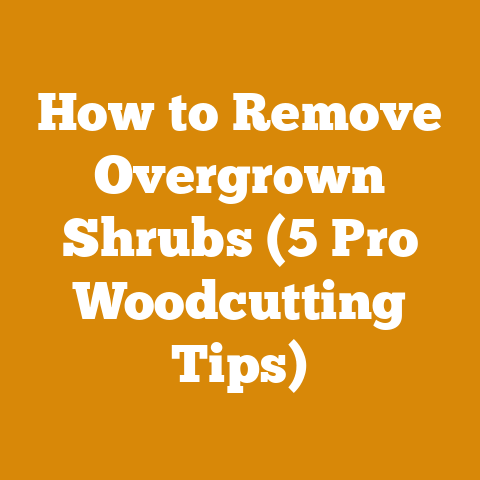Trimming Meyer Lemon Tree Tips (5 Pro Arborist Secrets)
The scent of Meyer lemons always takes me back.
Back to my grandfather’s small orchard, a sun-drenched haven where the air hummed with bees and the branches sagged heavy with golden fruit.
He wasn’t just a grower; he was a citrus whisperer.
I remember watching him, a wizened figure with hands gnarled like the branches he tended, pruning his Meyer lemon trees with a knowing touch.
He’d say, “A tree needs a haircut, just like you, to let the light in and breathe.” That simple wisdom, passed down through generations, is the foundation of everything I know about pruning these vibrant trees.
Now, after years of working with wood, timber, and even dabbling in small-scale logging, I’ve come to realize that the principles of pruning, whether for fruit trees or for managing forests, are surprisingly similar.
It’s all about understanding the wood, the growth patterns, and the desired outcome.
Today, I want to share with you some pro arborist secrets I’ve learned, not just from my grandfather, but from years of hands-on experience.
We’ll dive into the art and science of trimming Meyer lemon trees, ensuring a bountiful harvest and a healthy, thriving tree.
Trimming Meyer Lemon Trees: 5 Pro Arborist Secrets
1. Understanding Meyer Lemon Tree Growth Habits: The Key to Effective Pruning
Before you even pick up your pruning shears, it’s crucial to understand how Meyer lemon trees grow.
They are technically hybrids, a cross between a lemon and a mandarin orange, which gives them a slightly different growth habit than true lemons.
- New Growth: Meyer lemons produce fruit on new growth, typically the current or previous year’s wood.
This is a critical piece of information because it dictates when and how you prune.
Pruning too aggressively can remove the fruiting wood, reducing your harvest. - Growth Pattern: Meyer lemon trees tend to be more compact and less thorny than other lemon varieties.
They often have a rounded, bushy shape.
However, they can still become overcrowded if not properly managed. - Water Sprouts and Suckers: Like many fruit trees, Meyer lemons are prone to producing water sprouts (vigorous, upright shoots from the branches) and suckers (shoots emerging from the base of the tree or root system).
These steal energy from the tree and should be removed. - Bearing Age: Meyer lemon trees often start producing fruit within the first few years of planting, sometimes even in their first year.
This early fruit production is a bonus, but it also means that proper pruning from a young age is essential to shape the tree and encourage strong growth.
My Experience: I once worked with a client who had inherited a neglected Meyer lemon tree.
It was a tangled mess of branches, with very little fruit production.
After spending some time observing the tree, I realized that it was severely overcrowded, with many branches crossing and rubbing against each other.
By carefully thinning out the canopy and removing deadwood, we were able to improve airflow and sunlight penetration, leading to a significant increase in fruit production the following year.
2. The Right Tools for the Job: Chainsaws, Pruners, and More
Using the correct tools makes pruning easier, safer, and more effective.
Here’s a breakdown of essential tools for trimming Meyer lemon trees:
- Hand Pruners: These are essential for making clean cuts on branches up to about 3/4 inch in diameter.
I prefer bypass pruners, which make a cleaner cut than anvil pruners.
Look for pruners with comfortable grips and sharp, durable blades.
Brands like Felco, Corona, and ARS are known for their quality. - Loppers: Loppers are like larger hand pruners, designed for cutting branches up to about 2 inches in diameter.
They provide more leverage, making it easier to cut thicker branches.
Again, bypass loppers are generally preferred. - Pruning Saw: For branches larger than 2 inches, a pruning saw is necessary.
A curved blade saw with aggressive teeth will make quick work of thicker branches.
Consider a folding pruning saw for portability. - Pole Pruner: A pole pruner allows you to reach high branches without using a ladder.
These come in both manual and powered versions.
For most Meyer lemon trees, a manual pole pruner with a bypass cutting head is sufficient. - Chainsaw (Optional): While not always necessary for Meyer lemon trees, a small chainsaw can be useful for removing very large branches or for dealing with severely overgrown trees.
I typically use a lightweight electric chainsaw like the Stihl MSA 161 T for this type of work.
It’s quiet, easy to handle, and doesn’t produce exhaust fumes.
Safety is paramount when using a chainsaw.
Always wear appropriate PPE, including eye protection, hearing protection, gloves, and chaps. - Gloves: Protect your hands from thorns and scratches with a good pair of gardening gloves.
Leather gloves offer the best protection, but synthetic gloves can also be comfortable and durable. - Eye Protection: Safety glasses or a face shield are essential to protect your eyes from flying debris.
- Ladder: A sturdy ladder is necessary for reaching higher branches.
Choose a ladder that is appropriate for the height of your tree and always follow safety guidelines when using it.
Tool Maintenance: Keeping your tools sharp and clean is crucial for making clean cuts and preventing the spread of disease.
Sharpen your pruners and saws regularly with a sharpening stone or file.
Clean your tools with rubbing alcohol or a bleach solution after each use to disinfect them.
My Insight: I’ve found that investing in high-quality tools is well worth the cost.
Not only do they make pruning easier and more efficient, but they also last longer and provide better results.
I still use the Felco pruners my grandfather gave me decades ago.
3. Pruning Techniques: The Art of the Cut
Knowing where and how to make your cuts is just as important as having the right tools.
Here are some key pruning techniques for Meyer lemon trees:
- Thinning Cuts: Thinning cuts involve removing entire branches at their point of origin.
This opens up the canopy, improves airflow and sunlight penetration, and encourages new growth. - Heading Cuts: Heading cuts involve shortening a branch by cutting it back to a bud or side branch.
This encourages branching and can be used to control the size and shape of the tree.
However, heading cuts can also stimulate vigorous, upright growth, so use them sparingly. - Removing Dead, Diseased, or Damaged Wood: This is a fundamental principle of pruning.
Remove any dead, diseased, or damaged branches as soon as you notice them.
This prevents the spread of disease and improves the overall health of the tree. - Removing Crossing or Rubbing Branches: Branches that cross or rub against each other can create wounds that are susceptible to disease.
Remove one of the offending branches to eliminate the friction. - Removing Water Sprouts and Suckers: As mentioned earlier, water sprouts and suckers steal energy from the tree.
Remove them as close to the trunk or branch as possible. - “Open Center” Pruning: This technique involves creating an open center in the tree, allowing sunlight to reach the interior branches.
This is particularly important for fruit trees, as it promotes fruit production. - Angle of Cut: When making a heading cut, angle the cut slightly away from the bud you are cutting back to.
This will encourage the new growth to grow in the desired direction.
The Three-Cut Method for Large Branches: When removing large branches, use the three-cut method to prevent tearing the bark.
- Undercut: Make a cut on the underside of the branch, about 1/3 of the way through.
This will prevent the bark from tearing when the branch falls. - Top Cut: Make a cut on the top of the branch, a few inches further out than the undercut.
This will cause the branch to break off. - Final Cut: Make a final cut close to the trunk, just outside the branch collar (the swollen area where the branch joins the trunk).
This will allow the wound to heal properly.
My Tip: I always try to visualize the shape of the tree before I start pruning.
This helps me to make more informed decisions about which branches to remove.
I also take a step back frequently to assess my progress and make sure I’m not removing too much wood.
4. Timing is Everything: When to Prune Your Meyer Lemon Tree
The timing of your pruning is crucial for maximizing fruit production and maintaining the health of your tree.
- Ideal Time: The best time to prune Meyer lemon trees is in late winter or early spring, after the risk of frost has passed but before new growth begins.
This allows the tree to recover from the pruning before it starts producing new fruit. - Avoid Pruning During Active Growth: Avoid pruning during periods of active growth, as this can stress the tree and reduce fruit production.
- Summer Pruning (Light): Light pruning can be done in the summer to remove water sprouts and suckers, or to shape the tree.
However, avoid heavy pruning during the summer, as this can expose the tree to sunburn. - Young Trees: Young Meyer lemon trees should be pruned lightly and frequently to establish a strong framework.
Focus on removing crossing branches and shaping the tree. - Mature Trees: Mature Meyer lemon trees require less frequent pruning.
Focus on maintaining the shape of the tree, removing deadwood, and thinning out the canopy.
My Observation: I’ve noticed that trees pruned in late winter tend to produce more vigorous growth and more abundant fruit than trees pruned at other times of the year.
This is likely because the tree has the entire growing season to recover from the pruning and produce new fruiting wood.
5. Post-Pruning Care: Ensuring a Healthy Recovery
Pruning can be stressful for a tree, so it’s important to provide proper care after pruning to help it recover and thrive.
- Watering: Water the tree deeply after pruning to help it recover from the stress.
- Fertilizing: Fertilize the tree with a citrus-specific fertilizer to provide it with the nutrients it needs to produce new growth and fruit.
Follow the instructions on the fertilizer label carefully. - Mulching: Apply a layer of mulch around the base of the tree to help retain moisture, suppress weeds, and regulate soil temperature.
Keep the mulch a few inches away from the trunk to prevent rot. - Wound Sealer (Optional): While not always necessary, wound sealer can be applied to large pruning cuts to protect them from disease and pests.
I typically only use wound sealer on cuts larger than 2 inches in diameter. - Monitoring: Monitor the tree closely for signs of stress, disease, or pests after pruning.
Address any problems promptly.
Dealing with Pruning Waste:
What to do with the branches and leaves you’ve pruned?
Here are a few options:
- Composting: Small branches and leaves can be composted.
Shredding the material first will speed up the decomposition process. - Chipping: Larger branches can be chipped and used as mulch.
This is a great way to recycle the pruning waste and improve your soil.
I use a small wood chipper, typically powered by electricity, for this purpose.
Depending on the size of the branches, a chipper with a 2-3 inch capacity is usually sufficient. - Firewood: In some cases, larger branches can be used as firewood.
However, citrus wood is not the best firewood, as it tends to be smoky and doesn’t burn as hot as other types of wood.
Always check local regulations before burning any wood. - Disposal: If you can’t compost, chip, or use the pruning waste, you can dispose of it at your local landfill or yard waste facility.
Case Study: Reviving a Neglected Meyer Lemon Tree
I was once called in to assess a Meyer lemon tree that had been severely neglected for several years.
The tree was overgrown, with many dead and crossing branches.
It was also infested with scale insects.
Here’s how I approached the project:
- Assessment: I started by carefully assessing the tree to determine the extent of the damage and identify any underlying problems.
- Pruning: I began by removing all of the dead, diseased, and damaged wood.
I then thinned out the canopy, removing crossing branches and opening up the center of the tree.
I used the three-cut method for removing larger branches. - Pest Control: I treated the tree for scale insects with horticultural oil.
- Fertilizing: I fertilized the tree with a citrus-specific fertilizer.
- Mulching: I applied a layer of mulch around the base of the tree.
- Monitoring: I monitored the tree closely for signs of stress or pest re-infestation.
Over the course of the next year, the tree made a remarkable recovery.
It produced new growth, flowered profusely, and yielded a bountiful harvest of lemons.
This case study demonstrates the power of proper pruning and care in reviving a neglected Meyer lemon tree.
Strategic Insights:
- Long-Term Vision: Pruning is not just about short-term fruit production.
It’s about shaping the tree for long-term health and productivity. - Balance: Strive for a balance between vegetative growth and fruit production.
Too much vegetative growth can reduce fruit production, while too little vegetative growth can weaken the tree. - Observation: The most important skill for a pruner is observation.
Take the time to observe your tree, understand its growth habits, and identify any problems before you start pruning. - Continuous Improvement: Pruning is a skill that improves with practice.
Don’t be afraid to experiment and learn from your mistakes.
Next Steps:
Now that you have a better understanding of how to trim Meyer lemon trees, it’s time to put your knowledge into practice.
Start by assessing your own Meyer lemon tree and identifying any areas that need pruning.
Gather your tools, put on your safety gear, and get to work.
Remember to prune conservatively at first, and take a step back frequently to assess your progress.
With a little practice, you’ll be able to prune your Meyer lemon tree like a pro, ensuring a bountiful harvest and a healthy, thriving tree for years to come.
And remember that scent, the one that takes me back to my grandfather’s orchard?
That’s the real reward.
The scent of sunshine and sweet lemons, a testament to the power of careful cultivation and the enduring wisdom passed down through generations.
Now, go make some lemonade!






